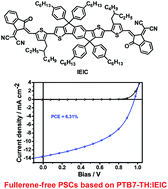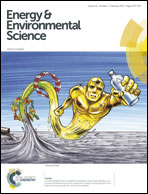High-performance fullerene-free polymer solar cells with 6.31% efficiency†
Abstract
A nonfullerene electron acceptor (IEIC) based on indaceno[1,2-b:5,6-b′]dithiophene and 2-(3-oxo-2,3-dihydroinden-1-ylidene)malononitrile was designed and synthesized. IEIC exhibited good thermal stability, strong absorption in the 500–750 nm region with an extinction coefficient of 1.1 × 105 M−1 cm−1 at 672 nm, deep LUMO energy level (−3.82 eV) close to those of fullerenes, and a relatively high electron mobility of 2.1 × 10−4 cm2 V−1 s−1. Fullerene-free polymer solar cells (PSCs) based on the blends of the IEIC acceptor and a low-bandgap polymer donor PTB7-TH, using a perylene diimide derivative as a cathode interlayer, showed power conversion efficiencies (PCEs) of up to 6.31%, which is among the best PCEs reported for fullerene-free PSCs.



 Please wait while we load your content...
Please wait while we load your content...